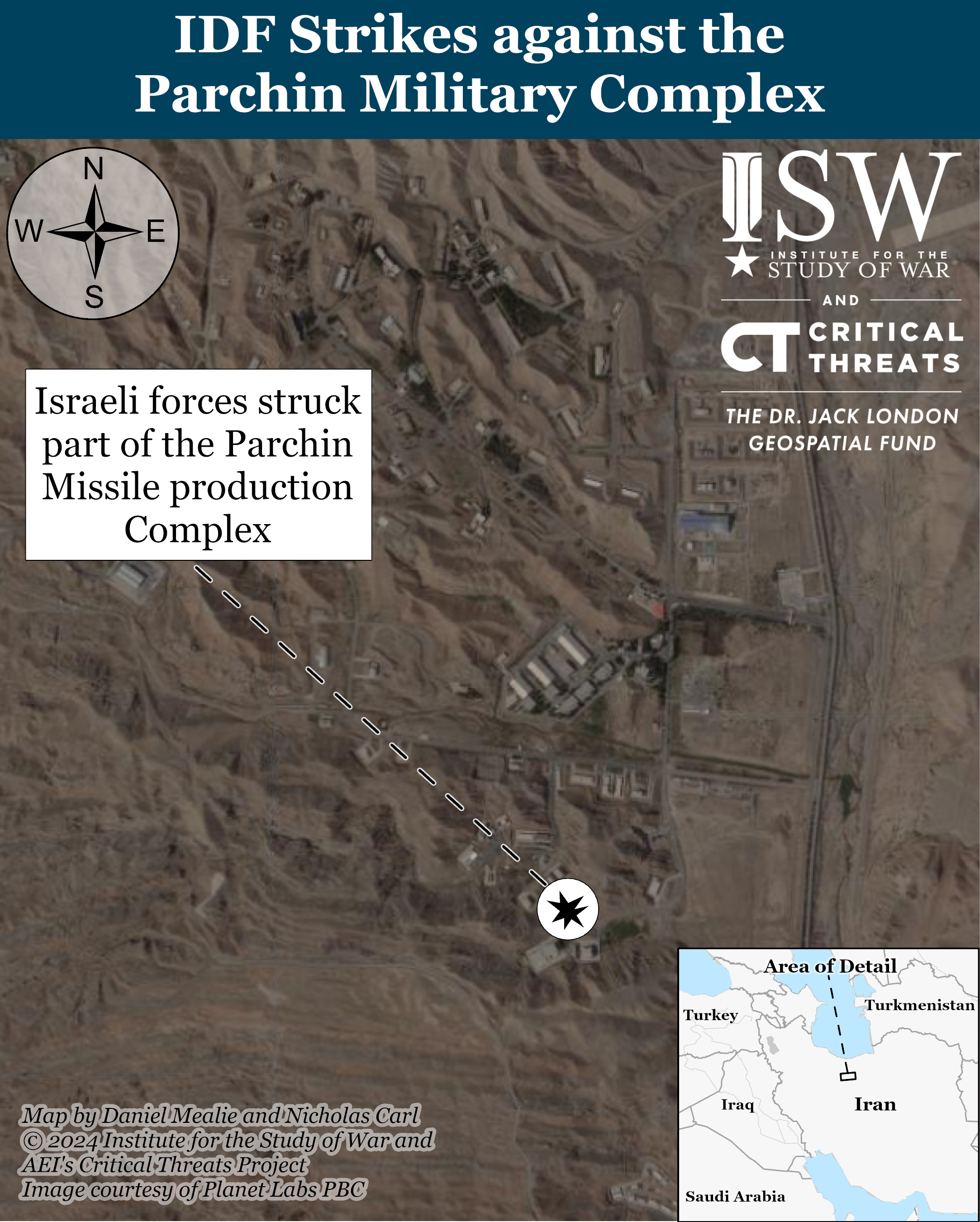{{currentView.title}}
October 26, 2024
Israeli Retaliatory Strikes on Iran
Israel launched several waves of strikes targeting around 20 locations in Iran last night using about 100 manned and unmanned aircraft. Israeli targets included highly sensitive air defense assets and facilities tied to the Iranian drone and missile programs.
Israeli strikes on Iranian drone and missile production facilities are significant as Iran has relied heavily on those systems in its regional war against Israel and sends these weapons to Russia, Hezbollah, and the Houthis.
We will update this page as more information on the Israeli strikes become available.
- Parchin military complex
Israel Defense Forces struck the Parchin military complex, east of Tehran, which is one of Iran’s most expansive and sensitive defense industrial sites. Iran has used the site to develop and manufacture explosive materials and advanced munitions, including drones and missiles,
The Parchin complex also played a key role in the Iranian nuclear weapons program. The regime historically used the site for high explosive testing for nuclear weapons development. International inspectors found traces of uranium at the site in 2015, indicating the presence of a larger quantity of uranium at one point, although Iran denied that the facility was tied to the nuclear program. [i]
Iran obfuscated the role of the Parchin complex in the nuclear weapons program over the years, as international organizations have raised questions about Iranian activities there. The regime has demolished, reconstructed, and paved over various parts of the facility, including those tied to high explosive testing for nuclear weapons. These changes have made it harder for international inspectors to retrieve reliable environmental samples. They also mean that the IDF strikes were not likely aimed at the facilities inspectors had been concerned about, since Iran has destroyed those. [ii]
Recent satellite imagery from @planet shows badly damaged buildings at the Parchin complex. This map includes older imagery of the site and points to the cluster of buildings that the IDF later hit. The newer imagery is blurry and makes it difficult to see the individual buildings, but we will publish clearer imagery as it becomes available over time.
The IDF strikes targeted sophisticated equipment used to produce solid fuel for long-range ballistic missiles. Iran gets this equipment from China and will likely need months or possibly a year to replace it. The loss of this equipment will disrupt Iran’s ability to replenish its stockpile of advanced missiles capable of reaching Israel.[iii]
- Khojir military complex
The IDF also struck the Khojir military complex, which is tied to the Parchin facility and involved in the production of liquid- and solid-fueled missiles for the IRGC. The Khojir site is tied to various state-owned defense companies including Shahid Hemmat Industries Group (SHIG). [iv]
SHIG is one of Iran’s “primary entities responsible for ballistic missile development and production,” according to the US. SHIG has been sanctioned by the US, EU, and the UN for its role in Iran’s nuclear and missile programs. [iv]
Iran began constructing new buildings at the Khojir complex in August 2023 to support missile production. Many of the buildings are surrounded by large dirt berms, indicating the nearby presence of highly combustible materials. Reuters reported that the expansion of the Khojir complex would increase Iran’s capacity to send weapons to Russia, Hezbollah, and the Houthis. [v]
Recent satellite imagery from @planet shows badly damaged buildings at the Khojir complex. This map includes older imagery of the site and points to the cluster of buildings that the IDF later hit. The newer imagery is blurry and makes it difficult to see the individual buildings, but we will publish clearer imagery as it becomes available over time.
The IDF strikes on Iran targeted several air defense sites, including an S-300 site near Eslam Shahr southwest of Tehran. The Amir ol Momenin Air Defense Brigade manages the S-300 equipment at the site. The brigade is part of the Artesh, which is Iran’s conventional military. Iranian state media has confirmed that at least four Artesh air defense officers died in the airstrikes, some of whom may have been at this site. It is not yet clear which component of the S-300 system the strike hit. [vi]
The S-300 is a Russian system, provided to Iran in 2016. It is the most advanced air defense system Iran has, and its arrival in Iran prompted concern about the ability of the US and/or Israel to hit targets in Iran easily. Ukrainian forces have regularly destroyed components of S-300 systems, on the other hand, and the recent IDF strike appears to show the system’s continued vulnerability to sophisticated targeting.[vii]
[i]https://www.wsj.com/articles/uranium-provides-new-clue-on-irans-past-nuclear-arms-work-1466380760
[ii]https://isis-online.org/isis-reports/detail/modifications-at-the-parchin-site-a-comprehensive-timeline-new-imagery-sugg/8#images
[iii] https://www.axios.com/2024/10/26/israel-strike-iran-missile-production
[iv] https://www.nytimes.com/2020/06/29/world/middleeast/iran-missile-explosion.html#:~:text=Looms%20in%20Gaza-,After%20Iranian%20Missile%20Facility%20Blows%20Up%2C%20Conspiracy%20Theories%20Abound%20in,at%20a%20different%20military%20base
[v] https://www.iranwatch.org/iranian-entities/shahid-hemat-industrial-group-shig
[vi] https://www.reuters.com/world/middle-east/satellite-photos-show-iran-expanding-missile-production-sources-say-2024-07-08/
[vii] https://www.bbc.com/news/articles/c5yr5ek4r8ro
[viii] https://kyivindependent.com/ukraine-destroyed-russian-s-300-s-400-radars-in-occupied-crimea-overnight-military-says/


